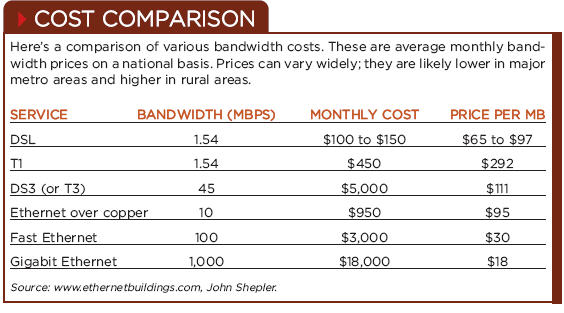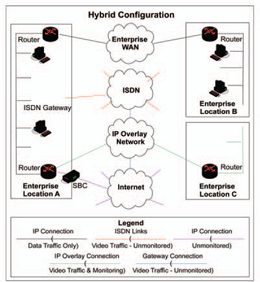There's no doubt that the demand for communications bandwidth has increased in recent years and that demand will continue to increase as more consumers, enterprises, and schools adopt IP-based technologies. Cisco estimates that global IP traffic will exceed half a zettabyte by 2012. (How much is a zettabyte? It's one trillion gigabytes.) To reach that number, Cisco says, global IP traffic will nearly double every two years. A major contributor to the growing bandwidth usage is video - peer to peer, TV, and video on demand being responsible for much of the increase. In the enterprise world, new bandwidth demands are coming from videoconferencing, video streaming, and VoIP applications.
Business videoconferencing primarily used ISDN data lines until just
- a few years ago. That changed around 2004, based on estimates by Wainhouse Research - during that year, IP became the most common method for hosting videoconference calls. Now, virtually all videoconferencing endpoints offer IP capability as the network standard; ISDN connectivity costs extra and, in some cases, is not available at all.
How are videoconferencing applications affecting bandwidth needs in the enterprise? A single high definition (HD) video call requires between 1 and 4 Mbps for optimal quality; a telepresence room could require 20-plus Mbps. Add extra conferencing rooms for daily collaboration, video streaming for employee training, your VoIP system, and so on, and your overall bandwidth requirement could be huge. Another important factor is the allowable burden on your network, which is typically less than 30 percent of the rated capacity. Although your HD call may only consume 1 to 4 Mb of network traffic, the network capacity needed to handle that burden could be in the range of 14 Mb. "A few years ago, companies needed just a couple megabytes of network service for videoconferencing; today, in many cases, they need 10, 20, 50 Mbps or more," says Ira Weinstein, senior analyst and partner at Wainhouse Research.
The way that companies are acquiring bigger bandwidth "pipes" is also evolving. "Ten years ago, companies were putting in point-to-point connections with dedicated T1s or DS3s, in effect building their own video network - so the cost of increasing bandwidth was massive," says Weinstein. "If you wanted to add a new location to your network, you had to add one (or more than one) T1 line." Weinstein says this method of bandwidth topology, although still in use within some enterprises, is less flexible than other options now available. "Cloud-based networks, such as MPLS (multi protocol label switching), have dramatically eased the cost of high-quality network transport," he says. "MPLS customers incur two types of costs; a local access fee for the connection (sometimes called the 'last mile' or 'local loop') between their building and the cloud, and a network access fee (called a port fee) for the traffic they'll be routing through the provider's backbone. Combined, these costs are typically much lower than the cost of creating your own end-to-end data network."

Your location is a prime factor in determining the price you'll pay for bandwidth. The closer you are to the service provider's point of presence (PoP), the less you'll have to pay. Another factor is the network performance or quality of service (QoS) required for your environment. "If you run multiple applications on a converged network, meaning you're putting video, audio, and standard traffic on a single LAN/WAN, QoS is a key part of maintaining audio and video performance while protecting other network traffic," says Weinstein. "Realtime applications cannot tolerate high levels of latency, packet loss, and jitter that occur on many networks. QoS allows an organization to prioritize real-time traffic over more forgiving, non-real-time traffic, like email and web browsing." According to Weinstein, most MPLS providers now offer a number of different QoS options at varying price points.
The volume you'll be buying also plays a huge role in the price you'll pay for bandwidth, says Dr. Mike Jude, research analyst at Nemertes Research. "If you're willing to buy bandwidth in large quantities, you tend to get a discount per bit," says Jude. One way to drive your costs down is to consolidate your traffic so you can buy a larger pipe. "For example,

a group of school districts could get together and negotiate as a single entity with carriers. If they can guarantee a certain level of service with that carrier, they will get better pricing," he says. The second way is to negotiate with multiple vendors, Jude suggests. "You can play the rates of one carrier against the rates of the other and get some advantageous pricing. Carriers are fiercely competitive; if you are willing to sign contracts for extended periods of time, you can build into those contracts options to renegotiate your pricing at periodic intervals, which will get you a better price up front."
Jude says another option is to leave the negotiating to someone else by using a "bandwidth manager" - a company that does not physically own any networks but purchases bandwidth in bulk from a number of vendors. A bandwidth manager is useful if you want route diversity - an important factor for enterprises that want quick disaster recovery, data security, etc. If one carrier's service slips, the bandwidth manager switches your service to a different carrier. If you are lucky enough to own a right of way (a physical location where fiber or other lines can be run), you have yet another option for reducing your bandwidth costs. "Some enterprises such as railroads who have extensive rights of way have planted fiber along those paths, and they can lease that fiber in exchange for service," Jude says. Some universities also have rights of way and access to spectrum that can give them bargaining power. "We know of one university that has some spectrum that they are allowing Verizon to use, and Verizon is in turn off ing them discounts for both spectrum and wired access," says Jude.
Network costs can be considerable, and CFOs always want to see justification for expenses. Wainhouse's Weinstein urges planning. "Enterprises should evaluate their network traffic and QoS requirements and purchase the appropriate network services," he says, but notes that the benefits of the network go beyond the numbers on the books. "Bandwidth is the circulatory system of the organization, and yes, it costs money," Weinstein says. "However, people need to realize that the network empowers productivity. Network-centric applications such as videoconferencing save time and money while increasing efficiency. For example, by using videoconferencing, a salesperson can meet with five significant clients in one day without leaving the office. Imagine the impact this would have on the bottom line. Similarly, senior managers in different locations can conduct face-to-face interviews with a job candidate over a single day without the hassle and expense of business travel. The result is that a four-week hiring cycle be mes only a few days. Imagine the benefit of enabling your global R&D team to meet face-to-face on a daily basis while working on a new product? Equipment prices may change, and bandwidth costs may vary, but the overall value these systems bring to the organization is massive. That's the real story."
